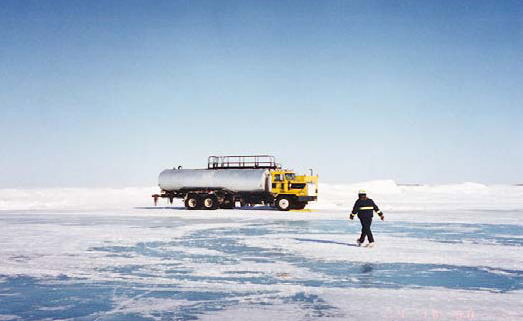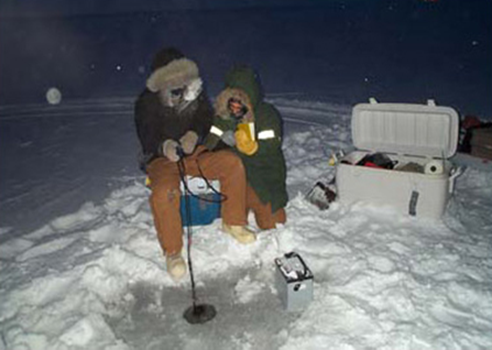Constructing ice roads and pads increases oilfield operators' access for exploration with little or no environmental disturbance. If a discovery is made and development is warranted and approved, ice roads and pads can be used to reduce the use of gravel roads and pads needed to support production facilities and pipelines. Construction of ice roads and pads begins in December or January, when the tundra is adequately frozen to support ice road construction. Traffic can continue on ice roads through April, depending on weather conditions. Water supplies are additionally needed to support facility operations.
Numerous questions exist regarding potential environmental consequences of such pumping, particularly because of the little water flow on the North Slope except during spring snowmelt. Possible effects include impacts to water balances, aquatic organisms (including fish and invertebrates), and like-water chemistry.
Project Results
The study has set 15 percent lake water volume usage as a standard. Preliminary assessment indicates that pumping 15 percent of the free water from these ponds and lakes does not negatively impact the ecology of the tundra.
Benefits
Establishment of the safe amount of water to be pumped from North Slope ponds and lakes is vital to the continued development and production of oil and gas and the economy of Alaska. The water-use issue will become increasingly important as development proceeds in the National Petroleum Reserve-Alaska (NPR-A) and other areas west of Prudhoe Bay.
Project Summary
In the fall of 2002, UAF's Water and Environmental Research Center, together with other project performers, initiated a study to obtain baseline information about the physical, biological, and chemical characteristics of North Slope lakes in order to help assess some of the major questions related to lake water use. Automated data collection stations on lakes provide hourly data that is updated on the project's Internet site at hourly intervals.
The study requires a complete understanding of the watershed hydrology at pumped and undisturbed lakes to quantify the potential impacts of water use. Continuous monitoring of selected hydrologic parameters and periodic sampling of water chemistry have been established for all test lakes (four pumped lakes and one control lake). The project established requirements for the selection of lake size, fish population present, watershed characteristics, and logistical access.
Criteria for evaluation included meteorological stations to calculate evaporative and condensation water flux, monitoring influx and outflow of streams entering or leaving ponds, groundwater flux and precipitation, monitoring changes in pond water volume during spring recharge and summer evaporative drawdown, monitoring the volume of pumped water, determining the spring snowpack water within the pond watershed area, monitoring snowmelt processes, and real-time monitoring of meteorological conditions, pond levels, and temperature.
Highlights of the 2004 season included completion of an annotated bibliography of North Slope water withdrawal and tundra lakes (BP Exploration), addition of a study lake at the Alpine Facility (ConocoPhillips), addition of a study lake in NPR-A (Bureau of Land Management), definition of the importance of watershed areas for determining recharge in the permit process, and the North Slope Borough providing communication resources for new western lakes. .
In their analysis of hydrologic processes, researchers determined that snowmelt and break up occur between April and June, and that recharge to lakes and ponds occur during this period. In this analysis, they used water chemistry sampling, meteorological analysis, soil thermostats, and a snow-water equivalent survey for each lake basin. Project performers were able to verify and document recharge during snowmelt for each lake.
The original geographic area was expanded, as two lakes in the NPR-A regions were added. Conoco Phillips Alaska and BP Exploration contributed two new rafts on the lakes for data collection.






